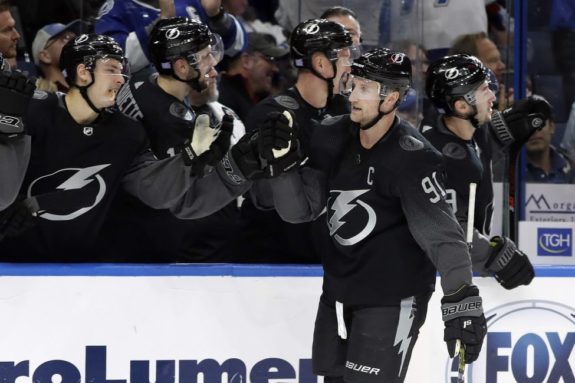To find a poster child for success in the modern NHL, look no further than the Tampa Bay Lightning.
That’s not really a revolutionary thought, or one that requires deep analysis to agree with. Tampa’s unique blend of youthful and veteran talent in every facet of their lineup elicits nothing short of awe, at least from me. As such, their third Stanley Cup Final appearance since 2015, and likely their second consecutive Cup win, feels deserved. For a while there, many pundits believed this Tampa core couldn’t do it. They missed the playoffs in 2017. They choked away a 3-2 series lead to the Washington Capitals in the 2018 Eastern Conference Final. They then became the laughingstock of the NHL in 2019.
But then, they won their Cup. And now, they’re (probably) going to do it again, in convincing fashion.
Many playoff viewers, myself included, pined for the Lightning to meet the Colorado Avalanche in this year’s Cup Final. For a minute, it looked very possible. The Avalanche held a 2-0 series lead against the Vegas Golden Knights, knocking on the door of the organization’s first Conference Final appearance since 2002. That is not what happened.
Now, the Avalanche face a crossroads of an offseason that could determine how the team will fare over the next half-decade and beyond. There are free agents to sign, an expansion draft to prepare for, and trades to ponder. If general manager Joe Sakic is looking for a blueprint to follow to help steady the ship following a disappointing ending to a promising season, I propose he steadies his gaze on the Bolts.
The Lightning Exemplify Versatility and Consistency
Perhaps the biggest lesson the Avalanche can learn from the Lightning is to believe in the team they’ve assembled and consistently add versatility to the lineup. Winning a Stanley Cup means playing a best-of-seven series against four different opponents, none of which play the game exactly the same way. This year, Tampa played against two faster teams in the Florida Panthers and Carolina Hurricanes, and two sturdier, grinding teams in the New York Islanders and Montreal Canadiens. The Lightning can thrive in either environment.
Colorado and Tampa both built the top end of their lineup in similar ways. They both drafted star players like Steven Stamkos, Nathan MacKinnon, Victor Hedman, and Cale Makar. They both traded disgruntled, high-profile players (Johnathan Drouin and Matt Duchene) for quality defensemen (Mikhail Sergachev and Samuel Girard). They both have filled out their rosters with complementary pieces that contribute on both ends of the ice.

So, the biggest difference between the two clubs, in my eyes, is that Lightning general manager Julien Brisebois is comfortable adding to the fringes of his lineup to make them an air-tight unit, particularly at the trade deadline. Adding Blake Coleman and Barclay Goodrow last season gave Tampa ample depth to plow through the playoffs even without Stamkos. Colorado added a good player in Vladislav Namestnikov, but couldn’t hold on to him as the Lightning did with their pieces.
This year, Tampa stayed hungry at the deadline and added defenseman David Savard. Even though he’s just been ok for them, he’s not the turnover time bomb the Avalanche added in Patrik Nemeth. The Avalanche also brought back Carl Soderberg, who had little in the tank left to offer them. Colorado was in position to add quality this year, but chose to not affect the chemistry of the group they already had.
The Lightning Exemplify Perseverance
Too often, teams will overreact to a disappointing season and make short-sighted and usually ill-fated moves. The Lightning would have been excused for doing so after their meltdown against the Columbus Blue Jackets. But the front office didn’t throw their lineup in a blender, instead opting to be patient and add talent when the time was right.
Latest Avalanche Content:
- Avalanche’s Makar Should Set Sights on Hart Trophy
- Top 10 Moments from the Avalanche’s 2021-22 Campaign
- Avalanche 2022 Offseason Trade Targets: Centers
- Oilers Should Target Avalanche In Big Blue Line Trade
- NHL Rumors: Maple Leafs, Blue Jackets, Senators, Avalanche
The Avalanche could be tempted to trade Nazem Kadri, or not re-sign Gabriel Landeskog for the sake of shaking things up and trying to light a spark. That, in my opinion, would be a foolish maneuver. The fact is, you don’t always win in the NHL. In fact, it’s really hard. The Lightning lost a lot of heartbreaking games in the 2010s, making the triumphs they’ve experienced in the 2020s that much sweeter. More heartbreak could be ahead for Colorado, but the key to MacKinnon, Makar, Mikko Rantanen, Landeskog, Girard, Devon Toews, and Alex Newhook winning their first Stanley Cup is to keep them together.

This is one of the best cores in the NHL, comparable to Tampa’s squad. But just like Tampa, that core might have to lose a lot before it wins. The front office needs to know when to add talent, but not at the cost of losing unnecessary pieces in the process. That’s not easy, not by a long shot.
But ask the Lightning. All the difficulty and waiting is so, so worth it.
(Also, another lesson to learn from Tampa is to sign Pat Maroon. The guy’s likely about to win his third straight Cup and second with the Lightning. Seems foolproof to me.)